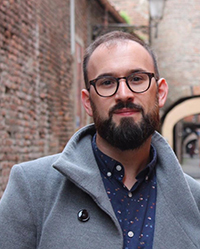 Iván Rey-Rodríguez. HNHP UMR 7194, CNRS / Muséum national d’Histoire naturelle / UPVD / Sorbonne Universités, Musée de l'Homme, Palais de Chaillot, 17 place du Trocadéro, 75016 Paris, France. Sezione di Scienze Preistoriche e Antropologiche, Dipartimento di Studi Umanistici, Università degli Studi di Ferrara, C.so Ercole I d’Este, 32 - 44121 Ferrara, Italy. ivanreyrguez@gmail.com
Iván Rey-Rodríguez. HNHP UMR 7194, CNRS / Muséum national d’Histoire naturelle / UPVD / Sorbonne Universités, Musée de l'Homme, Palais de Chaillot, 17 place du Trocadéro, 75016 Paris, France. Sezione di Scienze Preistoriche e Antropologiche, Dipartimento di Studi Umanistici, Università degli Studi di Ferrara, C.so Ercole I d’Este, 32 - 44121 Ferrara, Italy. ivanreyrguez@gmail.com
Iván Rey Rodríguez, PhD student from the Muséum National d´Histoire Naturelle (MNHN) in Paris and Università degli Studi di Ferrara (Italy). Graduated in History from Universidade de Santiago de Compostela (Galicia, Spain) in 2013. After that, He enrolled to the International Master in Quaternary and Prehistory (IMQP) at Universitat Rovira i Virgilli (Tarragona, Spain). His main research interests are taphonomy, taxonomy and palaeoecology in Southeastern Europe and Western Asia.

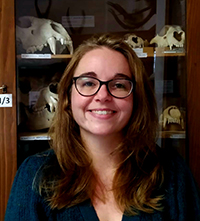 Julie Arnaud. Sezione di Scienze Preistoriche e Antropologiche, Dipartimento di Studi Umanistici, Università degli Studi di Ferrara, C.so Ercole I d’Este, 32 - 44121 Ferrara, Italy. rndjmr@unife.it
Julie Arnaud. Sezione di Scienze Preistoriche e Antropologiche, Dipartimento di Studi Umanistici, Università degli Studi di Ferrara, C.so Ercole I d’Este, 32 - 44121 Ferrara, Italy. rndjmr@unife.it
Julie Arnaud obtained her Ph.D in 2013 from the University of Ferrara (Italy) in collaboration with the Muséum national d’Histoire naturelle of Paris (France). At present she has a research fellow at the University of Ferrara. Her research focuses on human evolution in general and in the European Middle Pleistocene peopling.

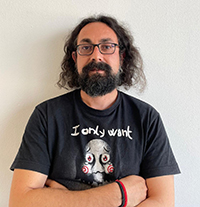 Juan-Manuel López-García. Institut Català de Paleoecologia Humana i Evolució Social (IPHES). Zona Educacional 4, Campus Sescelades URV (Edifici W3) 43007 Tarragona, Spain. Área de Prehistòria, Universitat Rovira i Virgili. Facultat de Lletres, Avinguda Catalunya 35, 43002 Tarragona, Spain. jmlopez@iphes.cat
Juan-Manuel López-García. Institut Català de Paleoecologia Humana i Evolució Social (IPHES). Zona Educacional 4, Campus Sescelades URV (Edifici W3) 43007 Tarragona, Spain. Área de Prehistòria, Universitat Rovira i Virgili. Facultat de Lletres, Avinguda Catalunya 35, 43002 Tarragona, Spain. jmlopez@iphes.cat
PhD in Prehistory at Universitat Rovira i Virgili (URV) and extraordinary dep. award (2007-2008), currently RyC researcher in Earth Sciences at IPHES. My interdisciplinary background allows me to work at the interface between Earth Sciences (Paleontology) and Humanities (Prehistory), as shown by most of my track record. Supported by various postdoctoral stages abroad, my main research line is focused on the small mammal studies in order to reconstruct the chronology, the environment and the climate during the Quaternary in Western Europe.

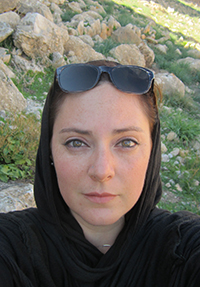 Emmanuelle Stoetzel. HNHP UMR 7194, CNRS / Muséum national d’Histoire naturelle / UPVD / Sorbonne Universités, Musée de l'Homme, Palais de Chaillot, 17 place du Trocadéro, 75016 Paris, France. emmanuelle.stoetzel@mnhn.fr
Emmanuelle Stoetzel. HNHP UMR 7194, CNRS / Muséum national d’Histoire naturelle / UPVD / Sorbonne Universités, Musée de l'Homme, Palais de Chaillot, 17 place du Trocadéro, 75016 Paris, France. emmanuelle.stoetzel@mnhn.fr
Emmanuelle Stoetzel graduated at the Muséum national d’Histoire naturelle (Paris, France) in 2009. After several postdoc in different laboratories in Paris and Bordeaux (France), she was recruited in 2016 as a permanent researcher at the Centre National de la Recherche Scientifique (Paris, France). Her research focuses on the Systematics, Evolution, Taphonomy and Paleoecology of Quaternary small vertebrates (North Africa, East Africa, Western Europe, Middle East). Part of an archaeology laboratory, she is particularly interested in exploiting the information provided by remains of small vertebrates from archaeological sites and contemporary natural sequences to provide a precise chronological, environmental and taphonomic framework for the human occupations.

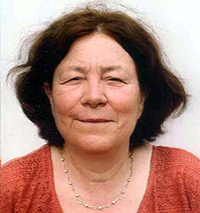 Christiane Denys. ISYEB UMR 7205, CNRS / Muséum national d’Histoire naturelle / UPMC / UA/ EPHE / Sorbonne Universités, Paris, France. christiane.denys@mnhn.fr
Christiane Denys. ISYEB UMR 7205, CNRS / Muséum national d’Histoire naturelle / UPMC / UA/ EPHE / Sorbonne Universités, Paris, France. christiane.denys@mnhn.fr
Prof C. Denys graduated in Palaeontology at the University Pierre and Marie Curie (Paris VI) in 1983 and passed an Habilitation in 1990 in the same place. She was named in 1990 at the french CNRS and spend 6 years as researcher at the Institute of Evolution Sciences in Montpellier (ISEM) II University. Since 1996 she is full Professor of Zoology at the Museum national d'Histoire Naturelle (Paris, France) and curator of rodent collections. Her main research themes concern the morphological and phylogenetical evolution of modern and fossil rodents since the Neogene in Africa as well as taphonomy and paleoecology of small vertebrates assemblages.

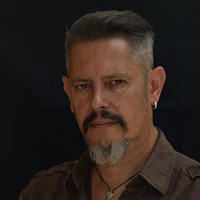 Raphaël Cornette. ISYEB UMR 7205, CNRS / Muséum national d’Histoire naturelle / UPMC / EPHE / Sorbonne Universités, Paris, France. raphael.cornette@mnhn.fr
Raphaël Cornette. ISYEB UMR 7205, CNRS / Muséum national d’Histoire naturelle / UPMC / EPHE / Sorbonne Universités, Paris, France. raphael.cornette@mnhn.fr
My general research framework concerns phenotypic variation. More precisely, I study relationships between form and function, this association being the principal target of natural selection. My methods of choice is morphometrics (traditional, geometric, in 2D and 3D). Vertebrates in an insular context present very interesting morpho-functional patterns that occupy the main part of my work. These approaches are also applied on archaeological and palaeontological specimens providing a better understanding of topics such as domestication and phenotypic evolution. My knowledge and my experience in morphometrics has resulted in numerous collaborations, for example with UMR 7209 : « Archéozoologie, archéobotanique », UMR 7179 : « Mécanismes Adaptatifs : des Organismes aux Communautés » and the UMR 7207 : « Centre de recherche sur la paléobiodiversité et les paléoenvironnements ».

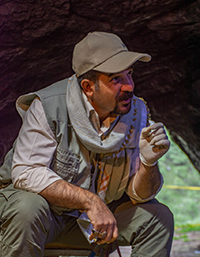 Behrouz Bazgir. Área de Prehistòria, Universitat Rovira i Virgili. Facultat de Lletres, Avinguda Catalunya 35, 43002 Tarragona, Spain. behrouz.urv@gmail.com
Behrouz Bazgir. Área de Prehistòria, Universitat Rovira i Virgili. Facultat de Lletres, Avinguda Catalunya 35, 43002 Tarragona, Spain. behrouz.urv@gmail.com
Behrouz Bazgir obtained his Ph.D in 2017 by awarding "Excelent with Distinction" from the University of Rovira i Virgili (Spain) in collaboration with the World Heritage Atapuerca Foundation and awarde his scholarship from there. At present he is a research member in the Institut Català de Paleoecologia Humana i Evolució Social (IPHES) Tarragona, Spain. His research focuses on human evolution in general and transition from Middle to Upper Paleolithic of Western Asia in specific. He directed several archaeological excavations on different sites in Iran, out of which, Kaldar Cave stands out as one of his field work jobs.

